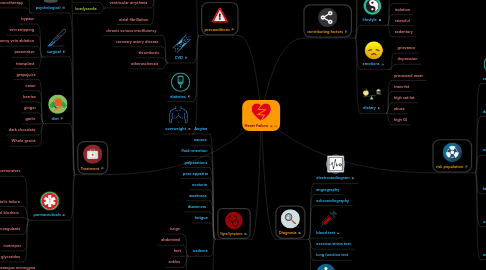
1. preconditions
1.1. Heart disease
1.1.1. coronary
1.1.2. congenital
1.1.3. ischemic
1.1.4. cardiomyopathy
1.1.4.1. hypertrophic
1.1.4.2. restrictive
1.1.4.3. congestive
1.1.5. hypertension
1.1.6. hypotension
1.1.7. ventricular arrythmia
1.1.7.1. tachycardia
1.1.7.2. bradycardia
1.1.8. atrial fibrillation
1.2. CVD
1.2.1. chronic venous insufficiency
1.2.2. coronary artery disease
1.2.3. thrombosis
1.2.4. atherosclerosis
1.3. diabetes
1.4. overweight
2. Signs/Symptoms
2.1. Angina
2.2. nausea
2.3. fluid retention
2.4. palpatations
2.5. poor appetite
2.6. nocturia
2.7. weakness
2.8. dizzinness
2.9. fatigue
2.10. oedema
2.10.1. lungs
2.10.2. abdominal
2.10.3. feet
2.10.4. ankles
2.10.5. legs
2.11. breathing trouble
2.11.1. pink phlegm
2.11.2. coughing
2.11.3. wheezing
2.11.4. dyspnoea
3. Treatment
3.1. yoga
3.2. psychological
3.2.1. stress management
3.2.2. chronotherapy
3.3. surgical
3.3.1. bypass
3.3.2. vein stripping
3.3.3. radiofrequency vein ablation
3.3.4. pacemaker
3.3.5. transplant
3.4. diet
3.4.1. grapejuice
3.4.2. onion
3.4.3. berries
3.4.4. ginger
3.4.5. garlic
3.4.6. dark chocalate
3.4.7. Whole grains
3.5. parmaceuticals
3.5.1. antihypertensives
3.5.1.1. aldosterone antagonists
3.5.1.2. diuretics
3.5.1.3. Angiotensin-converting enzyme inhibitors
3.5.1.4. angiotensin ii receptor blockers
3.5.2. systolic failure
3.5.2.1. beta blockers
3.5.3. calcium channel blockers
3.5.4. anticoagulants
3.5.4.1. aspirin
3.5.4.2. Warfarin
3.5.5. inotropes
3.5.6. glycosides
3.5.6.1. digitalis
3.6. herbal
3.6.1. Crataegus monogyna
3.6.1.1. stage 1 and 2
3.6.2. Panax noto-ginseng
3.6.2.1. inceases nitric oxide
3.6.2.2. vasoconstriction
3.6.3. Coleus forskohlii
3.6.3.1. antihypertensive
3.6.3.2. anticoagulant
3.6.4. Gingko biloba
3.6.4.1. anti-PAF
3.6.4.2. vasodilator
3.6.5. Zanthoxylum clava-herculis
3.6.5.1. circulatory stimulant
3.6.6. Aesculus hippocastanum
3.6.6.1. venotonic
4. contributing factors
4.1. toxicity
4.1.1. poisoning
4.1.2. overdose
4.2. genetics
4.3. lifestyle
4.3.1. environmental
4.3.2. habits
4.3.3. isolation
4.3.4. stressful
4.3.5. sedentary
4.4. emotions
4.4.1. grievance
4.4.2. depression
4.5. dietary
4.5.1. processed meat
4.5.2. trans-fat
4.5.3. high sat-fat
4.5.4. abuse
4.5.5. high GI
5. risk population
5.1. recovery
5.1.1. anticoagulants
5.1.2. after surgery
5.2. dependence
5.2.1. alcohol
5.2.2. drugs
5.2.3. cigerettes
5.3. western diets
5.3.1. lipid profile
5.3.2. refined food
5.3.3. caffeine
5.3.4. high sugar
5.4. family history
5.5. ageing
5.5.1. decreased kidney function
5.5.2. decrease cardiac output
5.5.3. decline in heart rate
5.6. work environment
5.6.1. sedentary
5.6.2. chemical exposure

